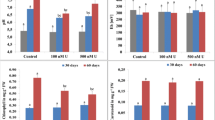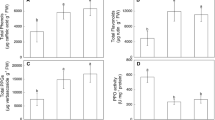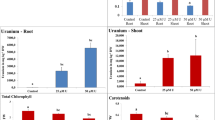Abstract
Plutonium associated with higher molecular weight molecules is presumed to be poorly mobile and hardly plant available. In our present study, we investigate the uptake and effects of Pu treatments on Solanum tuberosum plants in amended Hoagland medium at concentrations of [242Pu] = 100 and 500 nm, respectively. We found a direct proof of oxidative stress in the plants caused by these rather low concentrations. For the confirmation of oxidative stress, we explored the production of nitric oxide (NO) and hydrogen peroxide (H2O2) by epifluorescence microscopy. Oxidative stress markers like lipid peroxidation and superoxide radicals (O2 •−) are monitored through histochemical analysis. The biochemical parameters i.e. chlorophyll and carotenoids are measured as an indicator of cellular damage in the tested plants including the enzymatic parameters such as catalase and glutathione reductase. From our work, we conclude that Pu in low concentration has no significant effects on the uptake of many trace and macroelements. In contrast, the content of O2 •−, malondialdehyde (MDA), and H2O2 increases with increasing Pu concentration in the solution, while the opposite effects was found for NO, catalase, and glutathione reductase. These findings prove that even low concentration of Pu regulates ROS production and generate oxidative stress in S. tuberosum L.





Similar content being viewed by others
References
Aebi H (1984) Catalase in vitro. Methods Enzymol 52:121–126
Aranjuelo I, Doustaly F, Cela J, Porcel R, Müller M, Aroca R, Munné-Bosch S, Bourguignon J (2014) Glutathione and transpiration as key factors conditioning oxidative stress in Arabidopsis thaliana exposed to uranium. Planta 239:817–830
Arnon DI (1949) Copper enzyme in isolated chloroplast polyphenol oxidase in Beta vulgaris. Plant Physiol 24:1–15
Beligni MV, Lamattina L (2000) Nitric oxide stimulates seed germination and de-etiolation, and inhibits hypocotyl elongation, three light-inducible responses in plants. Planta 210:215–221
Bisinger T, Hippler S, Michel R, Wacker L, Synal HA (2010) Determination of plutonium from different sources in environmental samples using alpha-spectrometry and AMS. Nucl Instrum Method Phys Res Sec B 268:1269–1272
Bondietti EA, Reynolds SA, Shanks MH (1976) Interaction of plutonium with complexing substances in soils and natural waters. IAEA-SM-199/51. pp 273–287.
Bradford MM (1976) A rapid and sensitive method for the quantitation of microgram quantities of protein utilizing the principle of protein–dye binding. Anal Biochem 72:248–254
Brown KW, McFarlane JC (1978) Plutonium uptake by plants grown in soil containing plutonium-238-dioxide particles. Health Phys 35:481–485
Bunzl K, Kracke W, Schimmack W (1992) Vertical migration of plutonium-239+-240, americium-241 and cesium-137 fallout in a forest soil under spruce. Analyst 117:469–474
Chaki M, Valderrama R, Fernández-Ocaña AM, Carreras A, Gómez-Rodríguez MV, Pedrajas JR, Begara-Morales JC, Sánchez-Calvo B, Luque F, Leterrier M, Corpas FJ, Barroso JB (2011) Mechanical wounding induces a nitrosative stress by down-regulation of GSNO reductase and an increase in S-nitrosothiols in sunflower (Helianthus annuus) seedlings. J Exp Bot 62:1803–1813
Corpas FJ, Chaki M, Fernández-Ocaña A, Valderrama R, Palma JM, Carreras A, Begara-Morales JC, Airaki M, del Río LA, Barroso JB (2008) Metabolism of reactive nitrogen species in pea plants under abiotic stress conditions. Plant Cell Physiol 49:1711–1722
Corpas FJ, Gupta DK, Palma JM (2015) Production sites of reactive oxygen species (ROS) in plants. In: Gupta DK, Palma JM, Corpas FJ (eds) Reactive oxygen species and oxidative damage in plants under stress. Springer Publication, Germany, pp 1–22
Choudhury S, Panda SK (2004) Induction of oxidative stress and ultrastructural changes in moss Taxithelium nepalense (Schwaegr.) Broth. under lead and arsenic phytotoxicity. Curr Sci 87:342–348
de Brito Abreu C, do Lima Sacramento B, Alves AT, Moura SC, Pinelli MS, ADA N (2016) Nutritional and biochemical changes induced by lead in sunflower (Helianthus annuus L.) Ciências Agrárias 37:1229–1242
Degryse F, Verma VK, Smolders E (2008) Mobilization of Cu and Zn by root exudates of dicotyledonous plants in resin-buffered solutions and in soil. Plant Soil 306:69–84
Dixit V, Pandey V, Shyam R (2001) Differential antioxidative responses to cadmium in roots and leaves of pea (Pisum sativum L. cv. Azad). J Exp Bot 52:1101–1109
Duxbury AC, Yentsch CS (1956) Plankton pigment monograph. J Mar Res 15:93–101
Edwards EA, Rawsthorne S, Mullineaux PM (1990) Subcellular distribution of multiple forms of glutathione reductase in leaves of pea (Pisum sativum L.) Planta 180:278–284
Entwistle JA, Flowers AG, Nageldiner G, Greenwood JC (2003) Identification and characterization of radioactive ‘hot’ particles in Chernobyl fallout-contaminated soils: the application of two novel approaches. Mineralog Magaz 67:183–204
Federov YA, Bakurov AS, Fedorova MN, Rasulev F (1986) Behavior of plutonium in the soil and its entry into plants. Agrokhimiya 12:83–88
Francis CW (1973) Plutonium mobility in soils and uptake by plants: a review. J Environ Qual 2:67–70
Francis AJ, Dodge CJ (2015) Microbial mobilization of plutonium and other actinides from contaminated soil. J Environ Radioact 150:277–285
Francis AJ, Dodge CJ, Gillow JB (2006) Biotransformation of plutonium complexed with citric acid. Radiochima Acta 94:731–737
Gupta DK, Walther C (2014) Radionuclide contamination and remediation through plants. Springer-Verlag, Germany
Gupta DK, Huang HG, Nicoloso FT, Schetinger MRC, Farias JG, Li TQ, Razafindrabe BHN, Aryal N, Inouhe M (2013a) Effect of Hg, As and Pb on biomass production, photosynthetic rate, nutrients uptake and phytochelatin induction in Pfaffia glomerata. Ecotoxicology 22:1403–1412
Gupta DK, Inouhe M, Rodríguez-Serrano M, Romero-Puerta MC, Sandalio LM (2013b) Oxidative stress and arsenic toxicity: role of NADPH oxidases. Chemosphere 90:1987–1996
Gupta DK, Corpas FJ, Palma JM (2013c) Heavy metal stress in plants. Springer-Verlag, Germany
Gupta DK, Palma JM, Corpas FJ (2015) Reactive oxygen species and oxidative damage in plants under stress. Springer-Verlag, Germany
Gupta DK, Tawussi F, Hamann L, Walther C (2016) Moderate uranium disturbs the nutritional status and induces oxidative stress in Pisum sativum L. J Plant Physiol Pathol 4:1
Gupta K, Sengupta A, Chakraborty M, Gupta B (2016) Hydrogen peroxide and polyamines act as double edged swards in plant abiotic stress responses. Front Plant Sci 7:1343
Hamilton TF, Jernströem J, Martinelli RE, Kehl SR, Eriksson M, Williams RW, Bielewski M, Rivers AN, Brown TA, Tumey SJ, Betti M (2009) Frequency distribution, isotopic composition and physical characterization of plutonium-bearing particles from the Fig-Quince zone on Runit Island, Enewetak Atoll. J Radioanalyt Nucl Chem 282:1019–1026
Haschke JM, Allen TH, Morales LA (2000) Surface and corrosion chemistry of plutonium. Los Alamos Sci 26:252–273
Hsu YT, Kao CH (2004) Cadmium toxicity is reduced by nitric oxide in rice leaves. Plant Growth Regul 42:227–238
Huang H, Li T, Tian S, Gupta DK, Zhang X, Yang XE (2008) Role of EDTA in alleviating lead toxicity in accumulator species of Sedum alfredii H. Bioresour Technol 99:6088–6096
Jabs T, Dietrich RA, Dangl JL (1996) Initiation of runaway cell death in an Arabidopsis mutant by extracellular superoxide. Science 273:1853–1856
Jin JW, Xu YF, Huang YF (2010) Protective effect of nitric oxide against arsenic induced oxidative damage in tall fescue leaves. Afr J Biotechnol 9:1619–1627
Kashparov V, Ahamdach N, Levchuk S, Yoschenko V, Senko SF, Maloshtan I (2009) Dissolution of particles of irradiated nuclear fuel in the temporary storages of radioactive waste in Chernobyl zone: sources for radionuclides migration. In: Oughton DH, Kashparov V (eds) Radioactive particles in the environment. NATO Science for Peace and Security Series pp 139–156.
Kashparov V, Yoschenko V, Levchuk S, Bugai D, van Meir N, Simonucci C, Martin-Garin A (2012) Radionuclide migration in the experimental polygon of the red Forest waste site in the Chernobyl zone-part 1: characterization of the waste trench, fuel particle transformation processes in soils, biogenic fluxes and effects on biota. Appl Geochem 27:1348–1358
Kershaw PJ, Denoon DC, Woodhead DS (1999) Observations on the redistribution of plutonium and americium in the Irish Sea sediments, 1978 to 1996: concentrations and inventories. J Environ Radioact 44:191–221
Kersting AB, Efurd DW, Finnegan DL, Rokop DJ, Smith DK, Thompson JL (1999) Migration of plutonium in ground water at the Nevada test site. Nature 397:56–59
Kibria MG, Islam M, Osman KT (2009) Effects of lead on growth and mineral nutrition of Amaranthus gangeticus L. and Amaranthus oleracea L. Soil Environ 28:1–6
Kirsch R, Fellhauer D, Altmaier M, Neck V, Rossberg A, Fanghänel T, Charlet L, Scheinost AC (2011) Oxidation state and local structure of plutonium reacted with magnetite, Mackinawite, and Chukanovite. Environ Sci Technol 45:7267–7274
Lachner J, Christl M, Bisinger T, Michel R, Synal HA (2010) Isotopic signature of plutonium at Bikini atoll. App Rad Isotop 68:979–983
Lasat MM, Baker AJM, Kochian LV (1998) Altered Zn compartmentation in the root symplasm and stimulated Zn absorption into the leaf as mechanisms involved in Zn hyperaccumulation in Thlaspi caerulescens. Plant Physiol 118:875–883
Lee JH, Hossner LR, Attrep JRM, Kung KS (2002) Uptake and translocation of plutonium in two plant species using hydroponics. Environ Pollut 117:61–68
Leterrier M, Airaki M, Palma JM, Chaki M, Barroso JB, Corpas FJ (2012) Arsenic triggers the nitric oxide (NO) and S-nitrosoglutathione (GSNO) metabolism in Arabidopsis. Environ Pollut 166:136–143
Lin A, Zhang X, Zhu YG, Zhao FJ (2008) Arsenate-induced toxicity: effects on antioxidative enzymes and DNA damage in Vicia faba. Environ Toxicol Chem 27:413–419
Lipton WV, Goldin AS (1976) Some factors influencing the uptake of plutonium-239 by pea plants. Health Phys 31:425–430
Little CA, Whicker FW, Winson TF (1980) Plutonium in a grassland ecosystem at rocky flats. J Environ Qual 9:350–354
Livens FR, Baxter MS, Allen SE (1987) Association of plutonium with soil organic matter. Soil Sci 144:24–28
Manara A (2012) Plant responses to heavy metal toxicity. In: Furini A (ed) Plants and heavy metals. SpringerBrief in Biometals pp 27-53.
Marschner H (1986) Mineral nutrition in higher plants. Academic press, London, U.K.
Mello-Farias PC, Chaves ALS (2008) Biochemical and molecular aspects of toxic metals phytoremediation using transgenic plants. In: Tiznado-Hernández ME, Troncoso-Rojas R, Rivera-Domínguez MA (eds) Transgenic approach in plant biochemistry and physiology. Research Signpost, India
Mittler R, Vanderauwera S, Suzuki N, Miller G, Tognetti VB, Vandepoele K, Gollery M, Shulaev V, Van Breusegem F (2011) ROS signaling: the new wave? Trend Plant Sci 16:300–309
Muller RN (1978) Chemical characterization of local and stratospheric plutonium in Ohio soils. Soil Sci 125:131–136
Nishita H, Hamilton M (1980) The influence of several soil components and their interaction on plutonium extractability from a calcareous soil. Soil Sci 13:56–59
Novikov AP, Kalmykov SN, Utsunomiya S, Ewing RC, Horreard F, Merkulov A, Clark SB, Tkachev VV, Myasoedov BF (2006) Colloid transport of plutonium in the far-field of the Mayak production association, Russia. Science 314:638–641
Ouzounidou G, Ilias I, Tranopoulou H, Karatalgis S (1998) Amelioration of copper toxicity by iron on spinach physiology. J Plant Nutr 21:2089–2101
Pinder JE 3rd, KW ML, Adriano DC, Corey JC, Boni AL (1990) Atmospheric deposition, resuspension and root uptake of Pu in corn and other grain producing agroecosystems near a nuclear fuel facility. Health Phys 59:853–867
Poinssot C, Geckeis H (2012) Radionuclide behaviour in the natural environment: science, implications and lessons for the nuclear industry. Woodhead Publishing Ltd., Cambridge
del Río LA (2011) Peroxisomes as a cellular source of reactive nitrogen species signal molecules. Arch Biochem Biophys 506:1–11
Rodríguez-Serrano M, Romero-Puertas MC, Zabalza A, Corpas FJ, Gómez M, del Río LA, Sandalio LM (2006) Cadmium effect on oxidative metabolism of pea (Pisum sativum L.) roots. Imaging of reactive oxygen species and nitric oxide accumulation in vivo. Plant Cell Environ 29:1532–1544
Romero-Puertas MC, Corpas FJ, Rodríguez-Serrano M, Gomez M, del Rio LA, Sandalio LM (2007) Differential expression and regulation of antioxidative enzymes by cadmium in pea plants. J Plant Physiol 164:1346–1357
Salbu B, Krekling T, Oughton DH, Østby G, Kashparov VA, Brand TL, Day JP (1994) Hot particles in accidental releases from Chernobyl and wind scale nuclear installations. Analyst 119:125–130
Sandalio LM, Dalurzo HC, Gómez M, Romero-Puertas MC, del Río LA (2001) Cadmium-induced changes in the growth and oxidative metabolism of pea plants. J Exp Bot 52:2115–2126
Sandalio LM, Rodríguez-Serrano M, Gupta DK, Archilla A, Romero-Puertas MC, del Río LA (2012) Reactive oxygen species and nitric oxide in plants under cadmium stress: from toxicity to signalling. In: Parvaiz A, Prasad MNV (eds) Environmental adaptations and stress tolerance of plants in the era of climate change. Springer, Heidelberg, pp 199–215
Shahandeh H, Hossner LR (2002) Role of soil properties in phytoaccumulation of uranium. Water Air Soil Pollut 141:165–180
Shaibur MR, Kitajima N, Sugawara R, Kondo T, Huq SMI, Kawai S (2006) Physiological and mineralogical properties of arsenic-induced chlorosis in rice seedlings grown hydroponically. Soil Sci Plant Nutr 52:691–700
Siddiqui MH, Al-Whaibi MH, Basalah MO (2010) Role of nitric oxide in tolerance of plants to abiotic stress. Protoplasma 248:447–455
Siddiqui MH, Al-Whaibi MH, Ahmed MS, Basalah MO, Ali HM (2012) Effect of calcium and potassium on antioxidant system of Vicia faba L. under cadmium stress. Int J Mol Sci 13:6604–6619
Singh HP, Batish DR, Kohli RK, Arora K (2007) Arsenic-induced root growth inhibition in mung bean (Phaseolus aureus Roxb.) is due to oxidative stress resulting from enhanced lipid peroxidation. Plant Growth Reg 53:65–73
Singh HP, Kaur S, Batish DR, Sharma VP, Sharma N, Kohli RK (2009) Nitric oxide alleviates arsenic toxicity by reducing oxidative damage in the roots of Oryza sativa (rice). Nit Oxide 20:289–297
Smith IK, Vierheller TL, Thorne C (1989) Properties and functions of glutathione reductase in plants. Physiol Planta 77:449–456
Steinhauser G, Niisoe T, Harada KH, Shozugawa K, Schneider S, Synal HA, Walther C, Christl M, Nanba K, Ishikawa H, Koizumi A (2015) Post-accident sporadic release of airborne radionuclides from the Fukushima Daiichi nuclear power plant site. Environ Sci Technol 49:14028–14035
Tanyolac D, Ekmekci Y, Unalan S (2007) Changes in photochemical and antioxidant enzyme activities in maize (Zea maize L.) leaves exposed to excess copper. Chemosphere 67:89–98
Terry N, Ulrich A (1974) Effects of magnesium deficiency on the photosynthesis and respiration of leaves of sugar beet. Plant Physiol 54:379–381
Thompson SW, Molz FJ, Fjeld RA, Kaplan DI (2012) Uptake, distribution, and velocity of organically complexed plutonium in corn (Zea mays). J Environ Radioact 112:133–140
Vazquez MD, Poschenrieder C, Barcelo J (1987) Chromium (VI) induced structural and ultra-structural changes in bush bean plants (Phaseolus vulgaris). Ann Bot 59:427–438
Viehweger K, Geipel G, Bernhard G (2011) Impact of uranium (U) on the cellular glutathione pool and resultant consequences for the redox status of U. Biometals 24:1197–1204
Wang YS, Yang ZM (2005) Nitric oxide reduces aluminum toxicity by preventing oxidative stress in the roots of Cassia tora L. Plant Cell Physiol 46:1915–1923
Xiong J, Fu G, Tao L, Zhu C (2010) Roles of nitric oxide in alleviating heavy metal toxicity in plants. Arch Biochem Biophys 497:13–20
Yang X, Feng Y, He Z, Stoffella P (2005) Molecular mechanisms of heavy metal hyperaccumulation and phytoremediation. J Trace Elem Med Biol 18:339–353
Zheng J, Yamada M (2006) Plutonium isotopes in settling particles: transport and scavenging of Pu in the western Northwest Pacific. Environ Sci Technol 40:4103–4108
Zheng J, Tagami K, Watanabe Y, Uchida S, Aono T, Ishii N, Yoshida S, Kubata Y, Fuma S, Ihara S (2012) Isotopic evidence of plutonium release in the environment from the Fukushima DNPP accident. Sci Report 2:304
Acknowledgements
We acknowledge financial support from the BMBF for FT (funding 02S9082A) and DG (funding 02S9276D). AH thanks the Sasse foundation for their continuous support.
Author information
Authors and Affiliations
Corresponding author
Additional information
Responsible editor: Georg Steinhauser
Highlights
1. First time reporting the information related to plutonium NO and H2O2 localization in plants through epifluorescence microscopy.
2. First time reporting histochemical staining of plants under Pu stress.
3. Plutonium in low concentration has no significant effects on the uptake of many trace and macroelements.
4. At low concentration, the presence of Pu influences the production of ROS indirectly due to radiotoxicity.
5. Our finding proves that even low concentration of Pu regulates ROS production and generates oxidative stress in S. tuberosum L.
Electronic supplementary material
Supplementary Figure 1
(DOCX 9475 kb).
Rights and permissions
About this article
Cite this article
Gupta, D.K., Tawussi, F., Hölzer, A. et al. Investigation of low-level 242Pu contamination on nutrition disturbance and oxidative stress in Solanum tuberosum L.. Environ Sci Pollut Res 24, 16050–16061 (2017). https://doi.org/10.1007/s11356-017-9071-9
Received:
Accepted:
Published:
Issue Date:
DOI: https://doi.org/10.1007/s11356-017-9071-9




